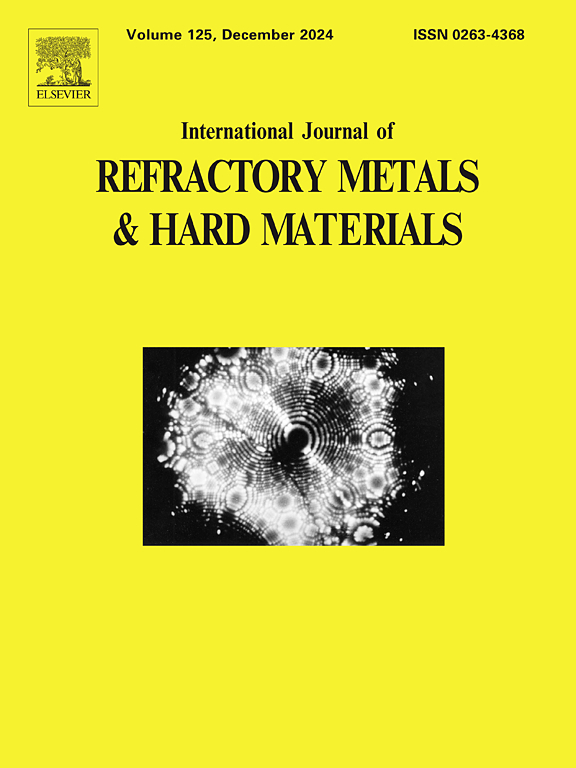Analysis of contact state and fracture mode of WC-10Co/B318 steel joint fabricated by resistance welding
IF 4.2
2区 材料科学
Q2 MATERIALS SCIENCE, MULTIDISCIPLINARY
International Journal of Refractory Metals & Hard Materials
Pub Date : 2025-01-31
DOI:10.1016/j.ijrmhm.2025.107083
引用次数: 0
Abstract
The dissimilar joining of B318 steel and two shapes (spherical and cylindrical) of WC-10Co pellets was performed using resistance welding for application in bimetal band saw blades. The study investigates the effects of pellet shape on joint characteristics and contact state by analyzing the welding process, dynamic resistance, temperature field, macroscopic and microscopic joint morphology, and fracture mode. The results indicated that the shear force of joints with different shapes initially increases before decreasing as the welding current rises. The welding range for the spherical joint is narrower than that for the cylindrical joint, and no reaction layer is formed at the joint. In contrast, the cylindrical joint exhibits a shear force of 1175.3N at 750 A, representing the highest value among the two shapes across various welding currents. Under this parameter, the thickness of the formed reaction layer of the cylindrical joint is moderate, with no severe element loss, and fractures occur in the steel's heat-affected zone (HAZ). High-speed photography results showed that spherical joints generate heat faster than cylindrical joints. Numerical simulation results indicated that the peak temperature in spherical joints is higher than in cylindrical joints. These differences can be attributed to variations in pellet curvatures of different shapes, leading to different contact states of the workpieces during welding. This affected the heat generation process, the amount of joint deformation, and the elemental migration and metallurgical reactions at the joint interface. Comparing all aspects, the welding performance of the cylindrical joint proves superior to that of the spherical joint.
电阻焊WC-10Co/B318钢接头接触状态及断裂方式分析
采用电阻焊方法,将B318钢与WC-10Co两种形状的颗粒(球形和圆柱形)进行异种连接,用于双金属带锯片的制作。通过分析焊接工艺、动电阻、温度场、宏观和微观接头形貌以及断裂方式,研究了球团形状对接头特性和接触状态的影响。结果表明:随着焊接电流的增大,不同形状接头的剪切力呈先增大后减小的趋势;球面接头的焊接范围比圆柱接头窄,且接头处不形成反应层。相比之下,圆柱接头在750 a时的剪切力为1175.3N,在不同的焊接电流下是两种形状中最大的。在此参数下,柱形接头形成的反应层厚度适中,没有严重的元素损失,在钢的热影响区(HAZ)发生断裂。高速摄影结果表明,球面接头比圆柱接头产生热量快。数值模拟结果表明,球面节点的峰值温度高于圆柱节点。这些差异可归因于不同形状的球团曲率的变化,从而导致焊接过程中工件的不同接触状态。这影响了热生成过程、接头变形量以及接头界面的元素迁移和冶金反应。通过对各方面的比较,证明了圆柱接头的焊接性能优于球面接头。
本文章由计算机程序翻译,如有差异,请以英文原文为准。
求助全文
约1分钟内获得全文
求助全文
来源期刊
CiteScore
7.00
自引率
13.90%
发文量
236
审稿时长
35 days
期刊介绍:
The International Journal of Refractory Metals and Hard Materials (IJRMHM) publishes original research articles concerned with all aspects of refractory metals and hard materials. Refractory metals are defined as metals with melting points higher than 1800 °C. These are tungsten, molybdenum, chromium, tantalum, niobium, hafnium, and rhenium, as well as many compounds and alloys based thereupon. Hard materials that are included in the scope of this journal are defined as materials with hardness values higher than 1000 kg/mm2, primarily intended for applications as manufacturing tools or wear resistant components in mechanical systems. Thus they encompass carbides, nitrides and borides of metals, and related compounds. A special focus of this journal is put on the family of hardmetals, which is also known as cemented tungsten carbide, and cermets which are based on titanium carbide and carbonitrides with or without a metal binder. Ceramics and superhard materials including diamond and cubic boron nitride may also be accepted provided the subject material is presented as hard materials as defined above.

 求助内容:
求助内容: 应助结果提醒方式:
应助结果提醒方式:


